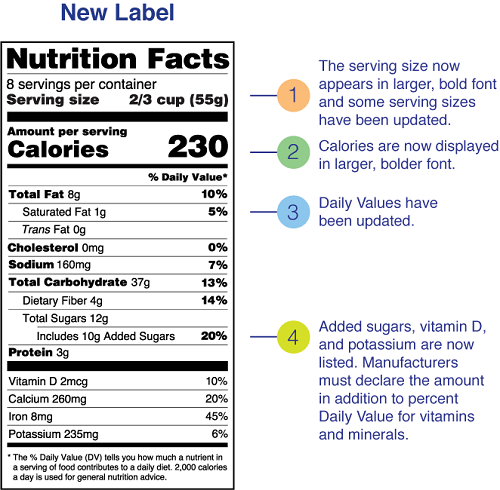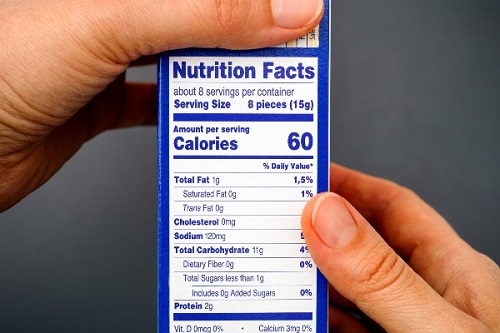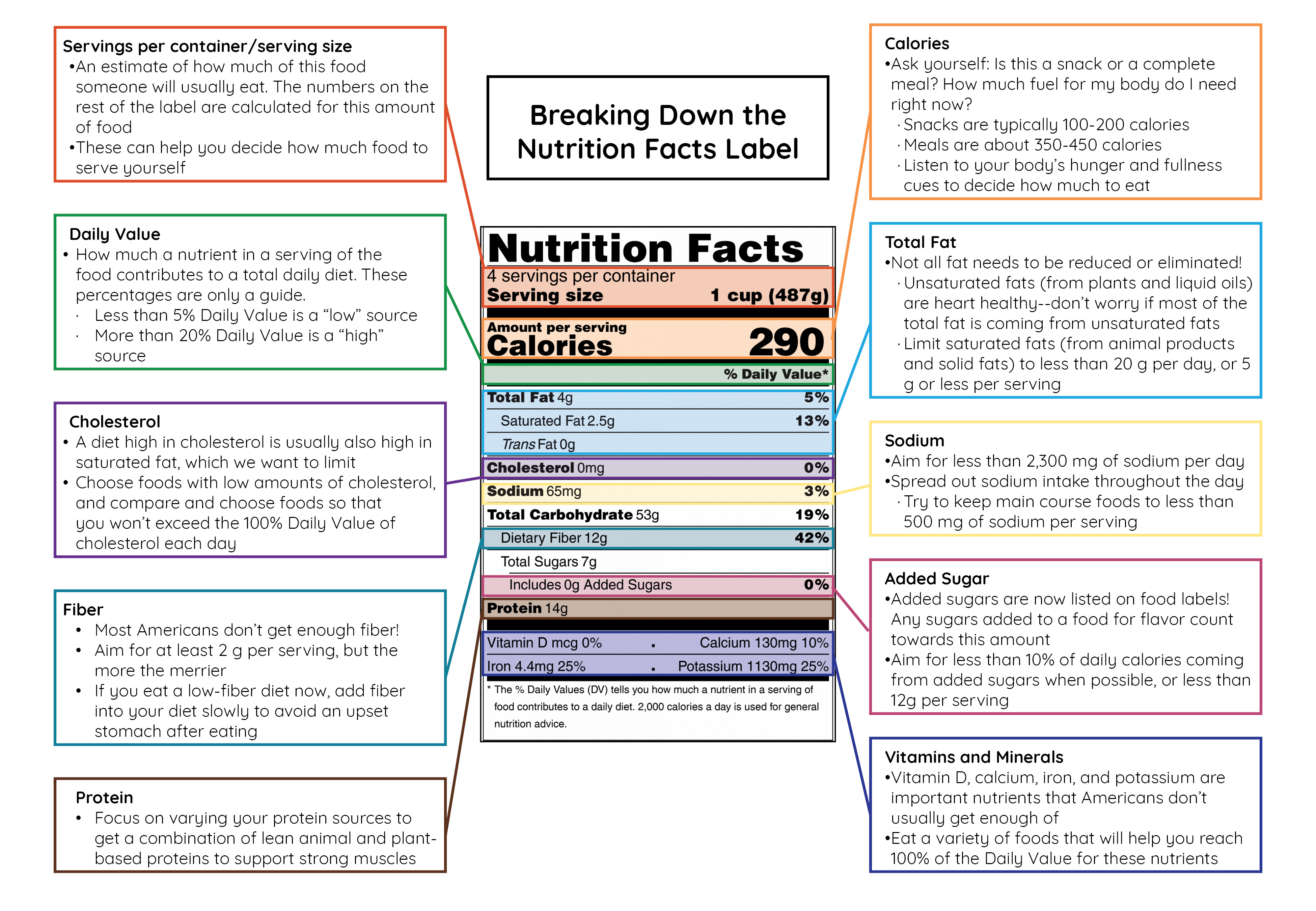The nutrition facts label is found on the packaging of almost every food product. It is a great way to help us be mindful of our food choices, but the small label packs in a lot of information! What does it all mean? Let’s break it down!
What is a nutrition facts label?
The nutrition facts label is a black and white box on the back or side of packaged foods. It gives us information on the nutrients in those foods. The nutrition facts label recently got a makeover that you can check out in our Got Nutrition Facts? blog and in the picture below:

- The serving size now appears in larger, bold font and some serving sizes have been updated.
- Calories are now displayed in larger, bolder font.
- Daily Values have been updated.
- Added sugars, vitamin D, and potassium are now listed. Manufacturers must declare the amount in addition to percent Daily Value for vitamins and minerals.
Why read a nutrition facts label?
The nutrition facts label has a lot of information, but you can choose to focus on the parts that will help you meet your nutrition needs.
For example, if you are trying to limit added sugars after reading our blogs on What’s the Deal with Sugar? (part 1 and part 2), you may focus on the Added Sugar line. If you want to support strong bones after reading our Healthy Aging series, you may focus on the Vitamins and Minerals.
Whatever your nutrition priorities are, the nutrition facts label can help! [2]

What’s on a nutrition facts label?
Let’s go line by line down the nutrition facts label:

Servings per Container and Serving Size
- Serving size is an estimate of how much of this food someone will usually eat. The numbers on the rest of the nutrition facts label are calculated for that amount of food.
- Servings per container is how many single servings is in the package of food. Both can help you decide how much to serve yourself if you want the same nutrients as what the nutrition facts label says.
Calories
- This is the amount of energy that a single serving provides. If you plan on eating more than one serving, the calories printed on the box will not be the same.
- Ask yourself: Is this a snack or a complete meal? How much fuel for my body do I need right now? Snacks are typically 100-200 calories, and meals are 350-450 calories, but listen to your body’s hunger and fullness cues to decide how much to eat.
Daily Value (%)
- The Daily Value is based on a 2,000-calorie diet, which may not apply to everyone. These percentages are only a guide.
- Less than 5% Daily Value is a “low” source, while more than 20% Daily Value is a “high” source.
- Have a nutrient you want to eat less of? Aim for foods with less than 5% Daily Value beside that nutrient. Have a nutrient you want more of? Look for foods with more than 20% Daily Value beside that nutrient.
Total Fat
- The number next to Total Fat is the sum of the other fat sources below it.
- Not all fat needs to be reduced or eliminated. Unsaturated fats (found in plant foods and liquid oils) are heart healthy but limiting saturated fat (found mostly in animal products and solid fats) is beneficial.
- Trans fat should be 0 g (grams) because it is no longer added to our foods. Keep saturated fats limited. Less than 5 g per serving or 20 g per day is a good guide.
- Don’t worry if most of the total fat is coming from unsaturated fats.
Cholesterol
- This refers to “dietary cholesterol,” or cholesterol that is not made by the body. A diet high in cholesterol is usually also high in saturated fat, which we want to limit.
- Choose foods that have a low amount of cholesterol. Compare and choose foods so that you won’t exceed the 100% Daily Value of cholesterol each day. Check out this handout to learn more about cholesterol.
Sodium
- Aim for less than 2,300 mg (milligrams) of sodium per day. That is only 1 teaspoon of table salt! To help spread out sodium intake throughout the day, try keeping main course foods less than 500 mg of sodium.
- For more information on what sodium is and what foods might be hiding sodium, read this blog about Where Salt Hides. For tips on reducing sodium, scroll through this blog on The Relationship Between Blood Pressure and Sodium.
Total Carbohydrates
- Like Total Fat, the number next to Total Carbohydrates includes all the sugar sources below it. It also adds up the carbohydrate sources that are naturally found in that food.
Fiber
- Fiber is found under Total Carbohydrates since many foods with fiber are also carbohydrates. Most Americans don’t get enough fiber!
- Aim for at least 2 g per serving, but the more the merrier. If you eat a low fiber diet now, add fiber sources slowly to avoid an upset stomach after eating.
Added Sugar
- Added Sugars are now listed on food labels! Aim for less than 10% of daily calories from added sugar when possible, or less than 12 g per serving.
- For more on this section of the food label, check out this What’s the Deal with Sugar? blog on how sugars are labeled.
Protein
- Protein needs are different for everyone. Focus on varying your protein sources (find protein ideas in our blog about food groups) to get a good combination of lean animal- and plant-based proteins to support strong muscles.
Vitamins and Minerals
- We get vitamins and minerals from the plant and animal products we eat. We need the right “mix” of these nutrients for best health.
- The nutrition facts label may have different nutrients listed, but there are four that are needed on the label: Vitamin D, calcium, iron, and potassium.
- Vitamin D, calcium, iron, and potassium are important nutrients that Americans don’t usually get enough of, so aim to eat a variety of foods that will help you reach 100% of the Daily Value for these nutrients.
Check out the FDA’s Interactive Nutrition Facts Label (available in English and in Español!). [2]
What does this mean for you?
Use the nutrition facts labels to guide what you buy if there are many similar options. Think about your overall diet, not just one meal or food product, to make food choices that will align with your overall nutrition needs.
Written by Melanie Ng, Ph.D. Student | Edited by Leslie Davis, MS, RDN, LD, CDCES and the Nutrition Team
Posted: January 25, 2021
[1] FDA – New Nutrition Facts Label
[2] Interactive Nutrition Facts Label